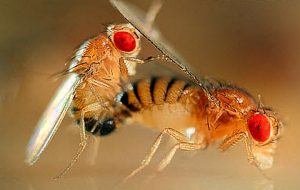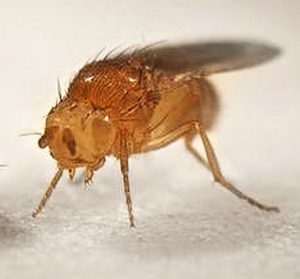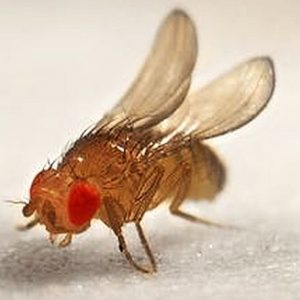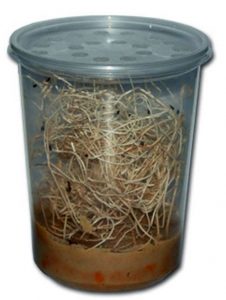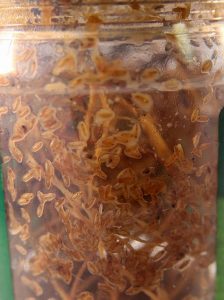Fruit Flies (Drosophila melanogaster) or Vinegar Flies are often bred by tropical fish keeping enthusiasts to feed topwater species like African Butterfly Fish, Archer Fish, Hatdhetfish, Killifish, etc.
Although Fruit Flies are sold in specialty pet shops and online for feeding young praying mantis, small spiders, frogs, fish, and a variety of other small insects, you can breed them yourself and save a good bit of money.
Flightless Fruit Flies like Drosophila hydei or Drosophila melanogaster have a mutation that makes their wings underdeveloped. Even though they still have wings, they are unable to fly.
The main difference between the two species is size. Drosophila melanogaster are small at about 1/16th of an inch long, whereas Drosophila hydei are meatier at about 1/8th of an inch long.
Breeding either species of Fruit Flies is easy and requires items you can find in your local supermarket.
You will need the following:
- An initial batch of Drosophila melanogaster or Drosophila hydei Fruit Flies.
- Seven or eight 10 to 20 oz. plastic containers with lids.
- Some tissue paper
- Mashed potato mix (without seasonings)
- Beer (any brand)
- White vinegar
- Dried yeast
- Some wood, plastic, or paper strips for the flies to sit upon
First, prepare the medium for feeding the Fruit Flies:
Mix about 17 to 18 oz. of beer with 7 oz. of mashed potato mix until smooth and add about 3.5 oz of white vinegar. The resulting mix should be smooth without being too watery. If it is too dry, add a small amount of water; if too wet, add some more mashed potato mix. When you’re happy with the consistency, add a tsp of dry yeast and stir well.
Next, prepare the breeding containers.
- Cut a hole in each of the container lids about the size of a half dollar.
- Take a piece of tissue paper and place it in between the lid and the container. The paper allows air into the container without letting the fruit flies escape.
- Add equal portions of the Fruit Fly medium to each of the containers. You don’t need to fill the containers up, but add just enough to cover the bottom.
- Add the wood or plastic strips into the containers on top of the medium. It should not sink into the medium. It needs to stay on top for the flies to perch on so they don’t drown.
Next, add the Fruit Flies.
Gently, shake or tap 20 to 30 Fruit Flies into each container and close the tissue paper fitted lid. Firmly tap the container so the fruit flies fall to the bottom, and set the containers in a 70° to 86° F. room for the Fruit Flies to develop.
The Fruit Flies take longer to develop at lower temperatures and should not be kept below 59 ° F.
The initial stock of Fruit Flies will lay eggs inside the medium and after a few days, tiny maggots will appear moving around inside the medium.
In about two weeks or so, when you see the orange/brown fly pupae sticking onto the side of the container, the next generation of Fruit Flies will be only a few days away.
The smaller fruit flies (Drosophila melanogaster) develop faster than the larger ones (Drosophila hydei).
After a couple of weeks, just about when the maggots reach adulthood, the medium in the containers will be dried up.
If you haven’t fed all the Fruit Flies to your fish or praying mantis, you can still keep them alive by adding a small piece of fruit or a little more culture medium to the container.
NOTE:
Both species of flightless fruit flies are capable of regenerating their ability to fly. Flightlessness is a recessive gene that both parents have to posses. If a wild fruit fly that can fly introduces its DNA into the gene pool, your flightless fruit flies will begin to “magically” fly again. So if you don’t want to deal with a bunch of annoying little fruit flies escaping and flying all over your house, keep your cultures safe from foreign fly DNA.
Fruit Flies are a great high protein live food for a variety of tropical fish species and are readily available from a variety of sources if you don’t care to breed them yourself.

